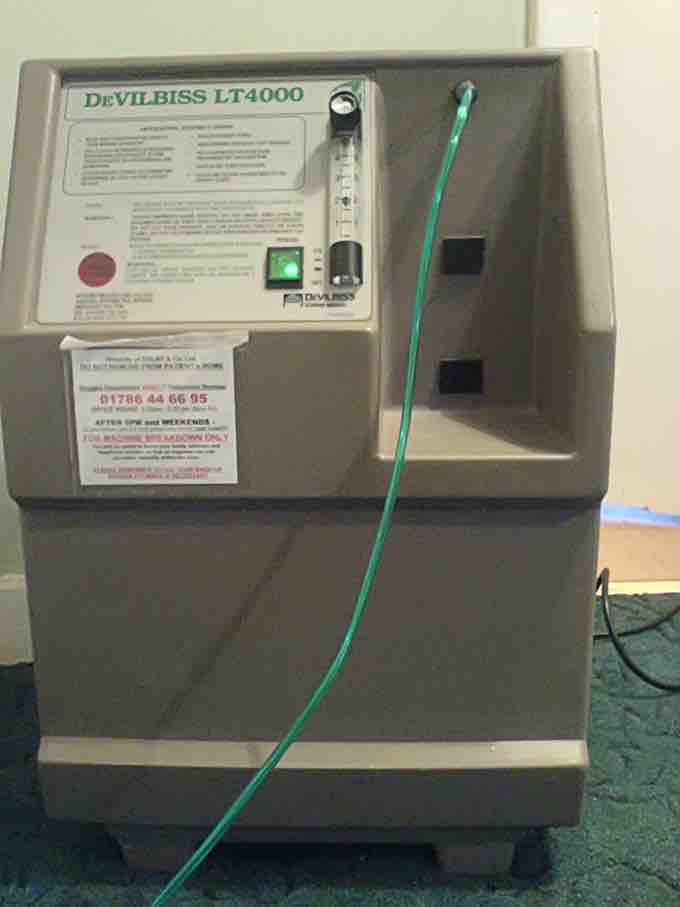Molecular dioxygen, O2, is essential for cellular respiration in all aerobic organisms. Oxygen is used in mitochondria to help generate adenosine triphosphate (ATP) during oxidative phosphorylation. Reactive oxygen species, such as superoxide ion (O2−) and hydrogen peroxide (H2O2), are dangerous by-products of oxygen use in organisms. Parts of the immune system of higher organisms, however, use reactive peroxide, superoxide, and singlet oxygen to destroy invading microbes. Reactive oxygen species also play an important role in the hypersensitive response of plants against pathogen attack. An adult human in rest inhales 1.8 to 2.4 grams of oxygen per minute. This amounts to more than 6 billion tons of oxygen inhaled by humanity per year.
Oxygen Therapy
One of the medical uses of oxygen is oxygen therapy. Uptake of O2 from the air is the essential purpose of respiration, so oxygen supplementation is used in medicine. Treatment not only increases oxygen levels in the patient's blood, but has the secondary effect of decreasing resistance to blood flow in many types of diseased lungs, easing the work load on the heart. Oxygen therapy is used to treat emphysema, pneumonia, some heart disorders (congestive heart failure), some disorders that cause increased pulmonary artery pressure, as well as any disease that impairs the body's ability to take up and use gaseous oxygen. Treatments are flexible enough to be used in hospitals, the patient's home, or increasingly by portable devices. Oxygen tents were once commonly used in oxygen supplementation, but have since been replaced mostly by the use of oxygen masks or nasal cannulas.

Oxygen Concentrator
An oxygen concentrator for an emphysema patient.
Hyperbaric Medicine
Hyperbaric (high-pressure) medicine uses special oxygen chambers to increase the partial pressure of O2 around the patient and, when needed, the medical staff. Carbon monoxide poisoning, gas gangrene, and decompression sickness (the 'bends') are sometimes treated using these devices. Increased O2 concentration in the lungs helps to displace carbon monoxide from the heme group of hemoglobin. Oxygen gas is poisonous to the anaerobic bacteria that cause gas gangrene, so increasing its partial pressure helps kill them. Decompression sickness occurs in divers who decompress too quickly after a dive, resulting in bubbles of inert gas, mostly nitrogen and helium, forming in their blood. Increasing the pressure of O2 as soon as possible is part of the treatment. Oxygen is also used medically for patients who require mechanical ventilation, often at concentrations above the 21% found in ambient air.
Use in Space Suits and Scuba Diving Suits
A notable application of O2 as a low-pressure breathing gas is in modern space suits, which surround their occupant's body with pressurized air. These devices use nearly pure oxygen at about one third normal pressure, resulting in a normal blood partial pressure of O2. This trade-off of higher oxygen concentration for lower pressure is needed to maintain flexible spacesuits.
Scuba divers and submariners also rely on artificially delivered O2, but most often use normal pressure and/or mixtures of oxygen and air. O2 use in diving at higher than sea-level pressures is usually limited to rebreather, decompression, or emergency treatment use at relatively shallow depths (~6 meters depth or less). Deeper diving requires significant dilution of O2 with other gases, such as nitrogen or helium, to help prevent oxygen toxicity. People who climb mountains or fly in non-pressurized fixed-wing aircrafts sometimes have supplemental O2 supplies.
Pressurized Commercial Airplanes
Passengers traveling in pressurized commercial airplanes have an emergency supply of O2 automatically supplied to them in case of cabin depressurization. Sudden cabin pressure loss activates chemical oxygen generators above each seat, causing oxygen masks to drop. Pulling on the masks "to start the flow of oxygen," as cabin safety instructions dictate, forces iron filings into a sample of sodium chlorate inside the canister where the reaction occurs. A steady stream of oxygen gas is then produced by the exothermic reaction.